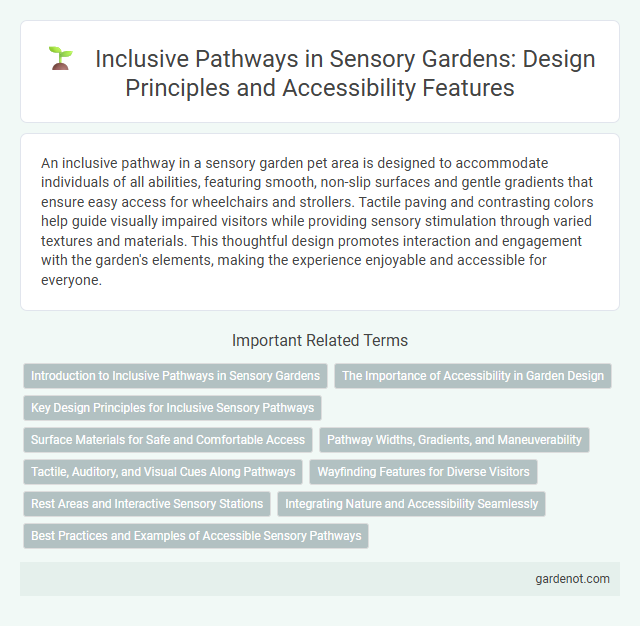An inclusive pathway in a sensory garden pet area is designed to accommodate individuals of all abilities, featuring smooth, non-slip surfaces and gentle gradients that ensure easy access for wheelchairs and strollers. Tactile paving and contrasting colors help guide visually impaired visitors while providing sensory stimulation through varied textures and materials. This thoughtful design promotes interaction and engagement with the garden's elements, making the experience enjoyable and accessible for everyone.
Introduction to Inclusive Pathways in Sensory Gardens
Inclusive pathways in sensory gardens are designed to provide accessible, safe, and engaging routes for individuals of all abilities, including those with mobility challenges or sensory impairments. These pathways feature tactile surfaces, varying textures, and clear, contrasting edges to enhance navigation and sensory exploration. Strategic placement ensures easy access to multisensory planting areas, water features, and interactive elements that stimulate sight, smell, touch, and sound.
The Importance of Accessibility in Garden Design
Inclusive pathways in sensory gardens prioritize accessibility by incorporating smooth, non-slip surfaces and gentle gradients that accommodate wheelchairs and mobility aids. Tactile paving and clear signage enhance navigation for individuals with visual impairments, promoting independent exploration. Designing accessible pathways ensures that people of all abilities can fully engage with the garden's sensory experiences, fostering inclusivity and connection with nature.
Key Design Principles for Inclusive Sensory Pathways
Inclusive sensory pathways optimize accessibility by integrating tactile surfaces, variable textures, and contrasting colors to engage diverse sensory perceptions. Key design principles emphasize gradual changes in elevation, clear wayfinding cues, and safe, non-slip materials to accommodate mobility aids and sensory impairments. Universal design standards guide the creation of pathways that promote comfort, independence, and interactive exploration for all users.
Surface Materials for Safe and Comfortable Access
Surface materials in an inclusive sensory garden pathway should prioritize non-slip, smooth textures such as rubberized coatings, compacted gravel, or permeable pavers to ensure safe and comfortable access for all users. These materials enhance tactile feedback for individuals with visual impairments and prevent trip hazards while accommodating wheelchairs and mobility aids. Proper drainage and cushioning properties further contribute to an accessible, durable path that supports diverse sensory experiences and physical abilities.
Pathway Widths, Gradients, and Maneuverability
Inclusive pathways in sensory gardens feature widths of at least 1.5 meters to accommodate wheelchairs and mobility aids, ensuring unobstructed access. Gradients are carefully maintained below 5% to provide ease of movement and prevent fatigue, complying with universal design standards. Maneuverability is enhanced through smooth, non-slip surfaces and ample turning space, facilitating a safe and comfortable experience for all visitors.
Tactile, Auditory, and Visual Cues Along Pathways
Inclusive pathways in sensory gardens integrate tactile surfaces like textured pavers and raised patterns to support navigation for visually impaired visitors. Auditory cues such as water features or wind chimes enhance spatial awareness and create an engaging soundscape. Visual elements including color-contrasted edging and strategically placed lighting improve wayfinding and safety for all users.
Wayfinding Features for Diverse Visitors
An inclusive pathway in a sensory garden integrates tactile paving, audible signals, and braille signage to enhance wayfinding for visitors with visual impairments. Clear color contrasts and textured surfaces support navigation for those with cognitive or physical disabilities. These features create a welcoming environment that ensures all visitors can independently explore and engage with the garden's sensory elements.
Rest Areas and Interactive Sensory Stations
Inclusive pathways in sensory gardens feature strategically placed rest areas designed to accommodate visitors with diverse mobility needs, ensuring comfort and accessibility throughout the space. Interactive sensory stations are integrated along the path, offering tactile, auditory, and olfactory experiences that engage all senses and encourage exploration. These elements promote an inclusive environment where visitors can pause, interact, and fully immerse themselves in the therapeutic benefits of the garden.
Integrating Nature and Accessibility Seamlessly
An inclusive pathway in a sensory garden blends natural elements with accessible design, ensuring smooth surfaces and gentle gradients for all mobility levels. Incorporating tactile paving, aromatic plantings, and varied textures enhances sensory engagement while maintaining navigable routes. This seamless integration fosters an environment where nature's healing benefits are accessible to everyone, promoting both physical access and sensory enrichment.
Best Practices and Examples of Accessible Sensory Pathways
Inclusive pathways in sensory gardens prioritize tactile, auditory, and olfactory elements to ensure accessibility for individuals with diverse sensory needs. Best practices include using non-slip, smooth surfaces with contrasting colors for visual clarity, integrating Braille signage, and incorporating sensory-rich materials like fragrant plants and textured paving. Notable examples such as the Chicago Botanic Garden and the Royal Botanic Gardens, Kew, demonstrate how accessible sensory pathways enhance engagement and navigation for visitors with disabilities.
Inclusive pathway Infographic

 gardenot.com
gardenot.com